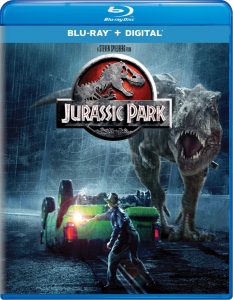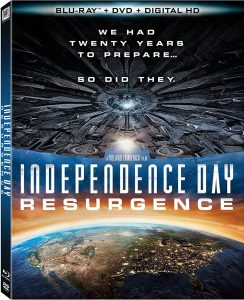“Independence Day: Resurgence” is what a summer blockbuster should be: the kind where after watching futuristic aerial dogfights (in 3D if you pay a couple extra bucks), you drive home as if your Honda Civic is a space fighter. But rather than being numbed by the two hours of pulse-laser-dodging action, viewers of this sequel to the 1996 blockbuster will have a smile on their face after getting to know a new batch of characters who fit in alongside the old favorites.
That’s not to say “ID:R” – again directed by Roland Emmerich, with he and Dean Devlin among the writers — is remotely original, just that it knows what it is, and it executes the material in slick fashion. Indeed, the plot is pretty much identical to the original; this would come off as lazy if it came out a couple years after “ID4,” but since it’s been 20 years, I’ll forgive them. Also in the film’s favor, we get more details this time around. We learn the reason for the aliens’ invasion, both then and now, and the aliens get further along in executing their grand plan for Earth. And it feels more personal this time: We see a lot of aliens up close, in all their back-tentacle-waving glory.
Jeff Goldblum comfortably slips back into the role of scientist David Levinson, whose quips add verisimilitude to scenes of dodging space debris at high speeds. Also picking up where he left off is scenery chewer Brent Spiner as Area 51 genius Dr. Brakish Okun, who benefits from the filmmakers’ post-production decision on “ID4” to make his presumed demise open-ended (the line “He’s dead” was cut at the last moment). He’s entertainingly enthusiastic about every technological and scientific discovery.
By contrast, former president Thomas Whitmore (Bill Pullman) is not quite the same after two decades – he seems to be in the early stage of dementia — and that makes him the most intriguing returning character. He gave that famous speech back in the day, but when he joins U.S. president Lanford (Sela Ward) at the podium celebrating the anniversary of Earth’s victory in the War of 1996, he mumbles and collapses. But later, heard by just a handful of pilots, he inadvertently gives another inspiring speech.
Like the original, “ID:R” achieves that difficult balance between the big picture of humanity coming together against a common foe, and specific relationship stories. Jake Morrison (Liam Hemsworth) and Patricia Whitmore (Maika Monroe, taking over for Mae Whitman as the president’s daughter) are pilots in love. Their pilot friends include Dylan Hiller (Jessie T. Usher, taking over for Ross Bagley as the stepson of Will Smith’s character) and Charlie (Travis Tope, who has a bit of a Milo Ventimiglia thing going). Charlie loves Rain (Angelababy; yes, that’s the actress’ name), a cute new squadron member, from afar.
Not all of the story perspective stays within the pilot family. In a parallel to the Randy Quaid subplot from the original, we find David’s dad (Judd Hirsch) leading a caravan of orphaned kids (including “Fargo’s” Joey King) across the country to Nevada’s Area 51, now a prominent military base.

The reason for the journey is that the 3,000-mile wide mothership has landed and crushed the entire Eastern seaboard (creating kind of an uneasy feeling if you’re sitting in a theater on the Eastern seaboard). This deliciously destructive sequence is one of many cases where “ID:R” is thrillingly bigger than “ID4,” which was one of the last great practical-effects movies, but still a product of its time. Stellar CGI shots include the mothership coming out of stealth mode; the city-destroyer ships using their gravity weapons to suck buildings, cars and people from the surface; and several close encounters with the aliens.
When viewed today, “ID4” is a bit clunky at times, but “ID:R” flows smoothly and answers every question about the aliens’ goals and the humans’ strategies as soon as a viewer wants to know the answer. It looks great – Barry Chisud’s production design wonderfully captures the look of a military enhanced by reverse-engineered alien tech – but also, the script caters to a more demanding audience.
That’s not to say there isn’t the occasional “huh?” moment. At the film’s beginning, an alien sphere comes out of a wormhole near the moon, and the united human armed forces – there are still countries, but a futuristic UN guides Earth’s military – quickly decides to shoot to kill. While the events of “ID4” brought humanity together, it seems we also hungered for an enemy over those two decades of playing with non-polluting gravity-drive fighter jets and pulse rifles.
When it turns out that the new arrival is actually friendly, the filmmakers completely let us Earthlings off the hook. There were no organic beings on board, so no one was killed, and no one faces consequences for the pre-emptive actions. Well, many of the decision-makers die, but the script isn’t punishing them for the wrongness of their actions.
An oddity of this alien-tech-enhanced 2016 is that most of the advancements gleaned from the 1996 war wreckage went into the military, almost none to non-military technology. The cars and cellphones are the same as in the real 2016. You’d think military technology would filter down to civilians and we’d see free-energy cars and buses. Is this a case where the government is hoarding the knowledge, as also seen in “The X-Files” miniseries, only more blatantly? If so, this could be a conflict worth exploring in a third movie.
But for now, this “Independence Day” entry is about people getting along regardless of race, creed, religion or nationality. One of the little subplots finds a nerdy UN liaison (Nicolas Wright) and an African warlord (Deobia Oparei) finding mutual respect, and it’s somehow not cheesy. Okun has a gay lover, but it’s played straight, so to speak. More than a couple women are skilled combat pilots, but it’s not worth remarking on. That’s the odd talent of this franchise: It delivers obvious, feel-good lessons about human commonalities without being preachy.
The “all in this together” theme is appropriate, because this franchise does aim for a common denominator: people who enjoy an alien-ass-kicking romp. “ID:R” – in the same way as “ID4,” only more so – shows that the common denominator doesn’t have to be the lowest; it’s possible to treat moviegoers with a level of respect while still operating the well-oiled, fun ride.

